Related Research Articles
AAL or Aal may refer to:
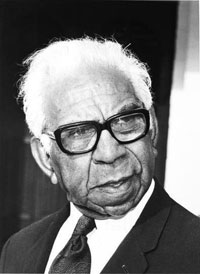
Sir Douglas Ralph Nicholls, was a prominent Aboriginal Australian from the Yorta Yorta people. He was a professional athlete, Churches of Christ pastor and church planter, ceremonial officer and a pioneering campaigner for reconciliation.
Aboriginal Protection Board, also known as Aborigines Protection Board, Aborigines Welfare Board, Board for the Protection of Aborigines and similar names, refers to a number of historical Australian state-run institutions with the function of regulating the lives of Aboriginal Australians. They were also responsible for administering the various half-caste acts where these existed and had a key role in the Stolen Generations. The boards had nearly ultimate control over Aboriginal people's lives.
Lin Onus, born William McLintock Onus, was an Australian artist of Scottish-Aboriginal origins.
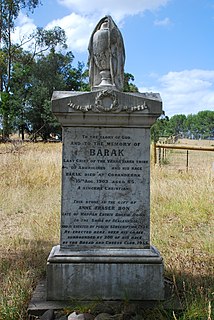
Coranderrk was an Aboriginal reserve, created by the Victorian government between 1863 and 1924, located 50 kilometres (31 mi) north-east of Melbourne. Under the protectionist policies of the time, the government provided land for Aboriginal people who had been dispossessed of their traditional lands by the arrival of European settlers to the colony of Victoria since the 1830s.
Indigenous Australian self-determination, also known as Aboriginal Australian self-determination, is the power relating to self-governance by Aboriginal and Torres Strait Islander peoples in Australia. It is the right of Aboriginal and Torres Strait Islander peoples to determine their own political status and pursue their own economic, social and cultural interests. Self-determination asserts that Aboriginal and Torres Strait Islander peoples should direct and implement Aboriginal and Torres Strait Islander policy formulation and provision of services. Self-determination encompasses both Aboriginal land rights and self-governance, and may also be supported by a treaty between a government and an Indigenous group in Australia.

The Yorta Yorta, also known as Jotijota, are an Aboriginal Australian people who have traditionally inhabited the area surrounding the junction of the Goulburn and Murray Rivers in present-day north-eastern Victoria and southern New South Wales.
Charles Duguid was a Scottish-born medical practitioner, social reformer, Presbyterian lay leader and Aboriginal rights campaigner who lived in Adelaide, South Australia for most of his adult life, and recorded his experience working among the Aboriginal Australians in a number of books. He founded the Ernabella mission station in the far north of South Australia. The Pitjantjatjara people gave him the honorific Tjilpi, meaning "respected old man". He and his wife Phyllis Duguid, also an Aboriginal rights campaigner as well as women's rights activist, led much of the work on improving the lives of Aboriginal people in South Australia in the mid-twentieth century.
Margaret Lilardia Tucker MBE was an Aboriginal Australian activist and writer.

The Australian Aborigines' League was established in Melbourne, Australia, in 1933 by William Cooper and others, including Margaret Tucker, Eric Onus, Anna and Caleb Morgan, and Shadrach James. Cooper was secretary of the League.
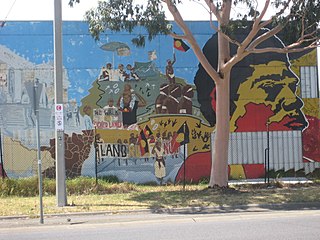
The Northcote Koori Mural is located in St Georges Road Thornbury, Victoria in the City of Darebin. It was designed by former Northcote High School art teacher Megan Evans in collaboration with members of the Thornbury-based Aborigines Advancement League, which owns the mural.
Mollie Geraldine Dyer (1927–1998) was a Yorta Yorta woman who was an Aboriginal Child Welfare Worker and Aboriginal community worker, best known for co-founding the Victorian Aboriginal Child Care Agency in 1977.
Margaret Wirrpanda was a campaigner for Australian Aboriginal rights.
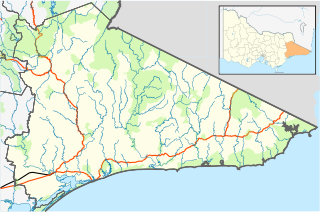
Lake Tyers Mission, also known as Bung Yarnda, was an Aboriginal mission established in 1863 on the shore of Lake Tyers in Victoria‘s Gippsland, region as a centralised location for Aboriginal people from around Victoria.
Evelyn Ruth Scott was an Indigenous Australian social activist and educator.
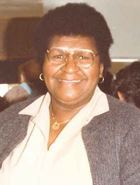
Eleanor Harding (1934-1996) was an Indigenous Australian from the Torres Strait Islands who worked to attain civil rights for aboriginal Australians. She advocated for women's rights and adequate educational opportunities, as well, serving with numerous organizations to attain equality for indigenous people. In 2012, she was inducted into the Victorian Aboriginal Honour Roll by the State of Victoria.
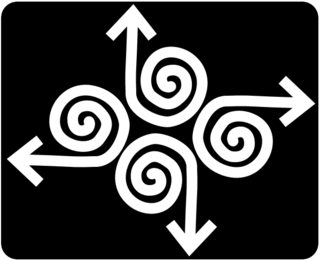
The Federal Council for the Advancement of Aborigines and Torres Strait Islanders (FCAATSI), founded in Adelaide, South Australia as the Federal Council for Aboriginal Advancement (FCAA) on 16 February 1958, was a civil rights organisation which campaigned for the welfare of Aboriginal Australians and Torres Strait Islanders, and the first national body representing Aboriginal interests. It was influential in lobbying in favour of the 1967 Referendum on Aboriginal Australians, before being renamed and split in two in 1970.
Joseph Daniel McGinness (1914–2003) was an Aboriginal Australian activist and the first Aboriginal president of the Federal Council for the Advancement of Aborigines and Torres Strait Islanders (FCAATSI).
Winnifred Evelyn Quagliotti was a Wurundjeri community leader. She was the great-great-niece of the Australian Aboriginal leader William Barak.
Elizabeth Maud Hoffman, née Morgan, also known as Aunty Liz or Yarmauk, was an Australian Indigenous rights activist and public servant. She co-founded the first Indigenous Woman's Refuge in Australia, named "The Elizabeth Hoffman House" in her honour. She was one of 250 women included in the Victorian Honour Roll of Women in 2001 and received the inaugural NAIDOC Lifetime Achievement Award in 2006.
References
- ↑ "Aborigines Advancement League Inc". State Government of Victoria. Dept. Human Services. Human Services Directory.
- ↑ "Victorian Aborigines Advancement League". Melbourne: the city, past and present. Retrieved 3 July 2019.
- 1 2 3 4 "Victorian Aborigines Advancement League". Archived from the original on 18 March 2012.
- ↑ Aboriginal Advancement League (ATNS)
- ↑ Australian Aborigines League – Institution – Reason in Revolt:Australian Aborigines League (1934- )
- ↑ Kerin, Rani (2017). "6. Adelaide-based activism in the mid-twentieth century: Radical respectability". In Brock, Peggy; Gara, Tom (eds.). Colonialism and its Aftermath: A history of Aboriginal South Australia. Wakefield Press. p. 115. ISBN 9781743054994.
- ↑ Moriarty, John (25 November 1996). "John Moriarty (1938)". National Museum of Australia (Interview). Interviewed by Sue Taffe. Archived from the original on 30 September 2009. Retrieved 22 March 2010.
- ↑ Onus, William Townsend (Bill) (1906–1968) Biographical Entry – Australian Dictionary of Biography Online
- ↑ "Who is Elizabeth Morgan". EMHAWS.ORG.AU. Retrieved 5 August 2020.
- ↑ "Magazine - Smoke Signals, Aborigines Advancement League, vol. 1, no.1, April 1960". Museum Victoria. Retrieved 5 July 2019.
- ↑ Aborigines Advancement League (Vic.) (1957), Smoke signals, Published for the Aborigines' Advancement League by Associated Publicity Services, ISSN 0049-0776
- ↑ ourcommunity.com.au – Directory of Organisations Archived September 3, 2007, at the Wayback Machine
- ↑ "Magazine - Smoke Signals, Aborigines Advancement League, Vol. 1, No. 1, Apr 1960". Museum Victoria. Archived from the original on 29 March 2014. Retrieved 28 March 2014.
- ↑ Minister opens refurbished Aborigines Advancement League (2/7/99) Archived September 28, 2007, at the Wayback Machine